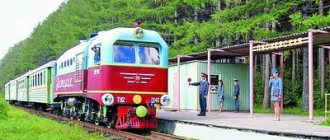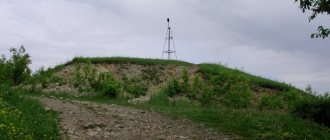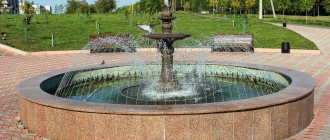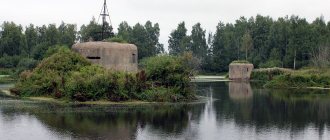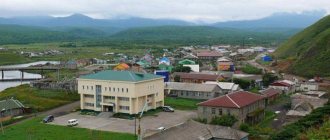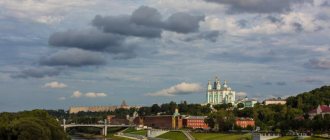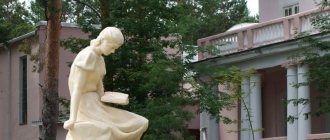Story
One of the four railway stations located in Likhvinsky district, Suvorovo, was located on the left bank of the Cherepet River, and on the opposite bank was the village of Suvorovo.
According to the stories of townspeople, the origin of the village of Suvorovo is as follows: it was founded by demobilized soldiers of Suvorov’s army. In 1934, the extraction of refractory clay began in the area, which was sent to the station. Suvorovo, and the mine with the village was named Suvorovsky. In 1949, construction began on the Cherepetskaya GRES, the new settlement of the power plant was also named Suvorovsky
.
In 1951, the village of Suvorovsky
was classified as a working village.
On August 12, 1954, the working village of Suvorovsky , Khaninsky
, was transformed into the city of regional subordination of Suvorov
.
February 28, 1958 district center of Khaninsky district
was moved from the working-class village
of Khanino
to the city of
Suvorov
, and the area was renamed Suvorovsky.
Population
| ↘ 16 919 | ↗ 19 343 | ↗ 21 885 | ↗ 21 900 | ↘ 21 800 | ↘ 21 600 | ||
| 2000 [6] | 2001 [6] | 2002 [10] | 2003 [6] | 2005 [6] | 2006 [6] | 2007 [6] | 2008 [6] |
| ↘ 21 200 | ↘ 21 100 | ↗ 21 213 | ↘ 21 200 | ↘ 20 500 | ↘ 20 300 | ↘ 20 100 | ↘ 19 900 |
| 2010 [11] | 2011 [6] | 2012 [12] | 2013 [13] | 2014 [14] | 2015 [15] | 2016 [16] | 2017 [2] |
| ↘ 18 973 | ↗ 19 000 | ↘ 18 610 | ↘ 18 299 | ↘ 18 015 | ↘ 17 829 | ↘ 17 615 | ↘ 17 506 |
Suvorov Museum of Local Lore
The museum begins its history in 1967; its opening was timed to coincide with the fiftieth anniversary of Soviet power. The museum itself is quite small; it is a small one-story house with three halls. The museum building often hosts meetings with war veterans, various interesting people, and excursions for school students. The exhibition “Provincial Antiquities” is of particular interest. It allows you to plunge into the life of people who lived on this land in the last century. Among the exhibits are many products made of wood, clay, castings, household items, etc.
Most of them were rescued directly by museum workers during historical and everyday expeditions in the Suvorov region. The museum also contributes to the cultural development of the city; many clubs and associations for young people of all ages successfully operate on its territory.
Location: Kalinina street - 2a.
Links
Useful
See what “Suvorov (city)” is in other dictionaries:
SUVOROV (city) - SUVOROV, city (since 1954) in the Russian Federation, Tula region, near the Zbrodovo railway station. Population 21.1 thousand people (2002). Bulky Yarn Factory; food industry. Museum of Local Lore. Near Suvorov Cherepetskaya State District Power Plant ... Encyclopedic Dictionary
Suvorov (city in the Tula region) - Suvorov, city (since 1954), the center of the Suvorovsky district of the Tula region of the RSFSR. Located 3 km from the railway station. from Zbrodovo station (on the Tula Kozelsk line) and 90 km west of Tula. 18 thousand inhabitants (1974). Book Publishing College. Near S. Cherepetskaya State District Power Plant, ... ... Great Soviet Encyclopedia
Suvorov - city, district center, Tula region. Originally the village of Suvorova with the name from the anthroponym: Suvor, Suvorov are recorded in documents of the 15th-16th centuries. In connection with the construction of the Cherepetskaya GRES, a working group was formed. village Suvorovsky, who in 1954 received the status ... Geographical Encyclopedia
SUVOROV is a city (since 1954) in the Russian Federation, Tula region, near the Zbrodovo railway station. 21.9 thousand inhabitants (1993). Bulky Yarn Factory; food industry. Museum of Local Lore. Near Suvorov Cherepetskaya State District Power Plant ... Big Encyclopedic Dictionary
Suvorov (meanings) - Suvorov is a Russian surname, formed as a patronymic from the Bulgaro Tatars. nicknames "Suvora" rider. To glorify the Suvorov family, a legend was created about the noble origin of the family from the Swede Suvor, who left for Russia in 1622... ... Wikipedia
SUVOROV - 1. SUVOROV Alexander Vasilyevich (1730 1800), Count of Rymnik (1789), Prince of Italy (1799), commander, generalissimo (1799). Began serving as a corporal in 1748. Participant in the Seven Years' War 1756-1763. During the Russian-Turkish wars (1768-74 and 1787-91) ... ... Russian history
Suvorov, Alexander Vasilyevich - (Prince of Italy, Count of Rymniksky) - Generalissimo of the Russian troops, Field Marshal of the Austrian Army, Grand Marshal of the Piedmontese troops, Count of the Holy Roman Empire, Hereditary Prince of the Sardinian Royal House, Grandee of the Crown and cousin ... Large biographical encyclopedia
Suvorov - Suvorov, Alexander Vasilyevich Alexander Vasilyevich Suvorov November 13 (24), 1729 May 6 (18), 1800 Count Alexander Vasilyevich of Italy, Count Suvorov of Rymnik ... Wikipedia
Suvorov - city, district center, Tula region. Originally the village of Suvorova with the name from the anthroponym: Suvor, Suvorov are recorded in documents of the 15th-16th centuries. In connection with the construction of the Cherepetskaya GRES, a working group was formed. village Suvorovsky, who in 1954 received the status ... Toponymic Dictionary
Source
Victory Memorial
There is probably no city in Russia in which there would not be a monument to the soldiers who died in the Great Patriotic War. In Suvorov there is also a full-fledged memorial complex dedicated to the Feat of Soviet soldiers. It includes a mass grave in which war dead are buried, where townspeople regularly bring fresh flowers.
Eternal flame and stele in honor of the fiftieth anniversary of Victory in the Great Patriotic War. The authors of the memorial complex were: architect Yu.N. Timokhin and Sculptor M.V. Prokofiev. Of particular note is the Alley of Heroes, also included in the Victory Memorial.
Transport
The city of Suvorov is located at a distance of 87 km from Tula, 55 km from Kaluga and 270 km from Moscow. The single-track diesel locomotive railway line Smolensk - Tula with a platform of 88 km (one pair of commuter trains Urvanka - Cherepet) and the Maloyaroslavets - Orel highway pass through the city. The Zbrodovo railway station is operational.
At 17 km of the Chekalin-Suvorov-Khanino highway (entrance to the city of Suvorov) there is a gas station. The city has a developed taxi system, with about six carriers operating. Suvorov is connected to Moscow by a direct bus route, which departs from the bus station three times a day.
House-Museum of A. Chekalin
Alexander Pavlovich Chekalin is a native of the Tula region, born in 1925 in the village of Peskovatskoye, Suvorovsky district. Since childhood, he was an excellent shot, was fond of hunting, and knew his way around the nearby forests well. In 1941, as a sixteen-year-old teenager, he joined the ranks of volunteers, and later ended up in a partisan detachment, whose commander was Teterichev.
It was while he was in the partisan detachment that Alexander became a scout; despite his young age, he, along with his elders, participated in collecting information about enemy troops, took part in ambushes and sabotage. One autumn, having caught a cold, Alexander returned to his home; the village head, seeing smoke from the chimney, reported this to the military commandant’s office. Soon the house was surrounded, and the partisan was asked to surrender, to which he responded with fire. After he ran out of ammunition, Alexander was captured, where he was subjected to terrible torture for several days.
Without revealing any information to the enemy, Alexander Pavlovich Chekalin was executed publicly in the city square. The memorial house-museum named after Alexander Chekalin was opened on the initiative of youth and Komsomol members in 1962. It contains the hero’s personal belongings, as well as information stands telling about the activities of the “Advanced” partisan detachment.
Location: Peskovatskoe village.
Suvorov
(Tula region)
City of district subordination (Suvorovsky district, Tula region) Center:
Suvorovsky district
| Telephone code (reference phone) | |
| 48763***** | 22-555 |
Deviation from Moscow time, hours:
0
Geographic latitude:
54°07′
Geographic longitude:
36°30′
Altitude above sea level, meters:
190 Sunrise and sunset times in the city of Suvorov
Suvorov: photo from space (Google Maps) Suvorov: photo from space (Microsoft Virtual Earth)
| Suvorov. Nearest cities. Distances in km. on the map (in brackets along roads) + direction. Using the hyperlink in the distance , you can get the route (information courtesy of the AutoTransInfo website) | |||
| 1 | Chekalin | 16 (16) | Z |
| 2 | Odoev | 23 (28) | SE |
| 3 | Przemysl (Kaluga region) | 27 (33) | NW |
| 4 | Dubna | 30 (53) | IN |
| 5 | Sosensky | 35 (85) | Z |
| 6 | Belev | 42 (56) | SW |
| 7 | Arsenyevo | 43 (52) | YU |
| 8 | Kaluga | 46 (57) | WITH |
| 9 | Kozelsk | 47 (70) | Z |
| 10 | Ferzikovo (Kaluga region) | 47 (91) | WITH |
| 11 | Vorotynsk (Kaluga region) | 48 (76) | NW |
| 12 | Aleksin | 56 (103) | NE |
| 13 | Babynino (Kaluga region) | 57 (67) | NW |
| 14 | Leninist | 65 (100) | IN |
| 15 | Pervomaisky | 66 () | IN |
| 16 | Shchyokino | 67 (89) | IN |
| 17 | Plavsk | 69 (107) | SE |
| 18 | Plekhanovo | 70 () | IN |
| 19 | Tovarkovo (Kaluga region) | 71 (92) | NW |
| 20 | Tula | 73 (85) | IN |
| 21 | Sukhinichi | 74 (102) | Z |
| 22 | Sovetsk | 76 (102) | IN |
| 23 | Ulyanovo (Kaluga region) | 76 (118) | SW |
| 24 | Detchino (Kaluga region) | 78 () | WITH |
| 25 | Black | 78 (113) | YU |
| 26 | Lipki | 80 (101) | IN |
| 27 | Tarusa | 80 (132) | NE |
| 28 | Bolkhov | 81 (101) | SW |
| 29 | Meshchovsk | 82 (104) | Z |
| 30 | Kondrovo | 84 (100) | NW |
a brief description of
Located in the northern part of the Central Russian Upland, 3 km from the railway. Zbrodovo station, 90 km west of Tula.
Territory (sq. km): 26
Historical sketch
Workers' settlement Suvorovsky since 1951 City since 08/12/1954
Economy
JSC Suvorov Mining Administration (clay, marl, etc.).
Cherepetsky plant of reinforced concrete products and structures, Mitinsky iron foundry, Khaninsky valve plant (iron casting, valves).
JSC "Suvorovskaya thread" (bulk yarn), "Leskhozmash" (including agricultural machines).
Main enterprises
TEXTILE INDUSTRY
Culture, science, education
Museums, galleries, exhibition halls
House-Museum of A. Chekalin 301422, Tula region, Suvorovsky district, village. Peskovatskoe
Suvorov Regional Museum of Local Lore 301430, Tula region, Suvorov district, Suvorov, st. Kalinina, 2-a Phone(s): (48763) 2-0256
Art Museum of Suvorov 301430, Tula region, Suvorov district, Suvorov, st. Pionerskaya, 3
Suvorov careers
The Suvorovsky district used to be very rich in minerals, the extraction of which was actively carried out during Soviet times. Our contemporaries have inherited landscapes of unimaginable beauty; in particular, it is worth highlighting the Suvorov quarries, where clay was previously mined.
Today you can no longer find equipment and workers here; instead, your eyes will see a stunning picture of a man-made landscape with hills up to fifty meters high and deep lakes with characteristic blue water.
The Suvorov quarries are a favorite vacation spot not only for local residents; on weekends you can meet a huge number of guests from other regions, including from Tula and Moscow. Therefore, if you plan to spend the weekend here, there is a high probability that all the numerous parking lots will already be occupied.
Industry
Cherepetskaya GRES is a coal-fired boiler-turbine condensing power plant with an installed capacity of 1285 MW; During the reform, it became part of OGK-3.
Suvorov electrical networks of JSC Tulenergo.
Cherepetsky plant of reinforced concrete products and structures OJSC SPK Mosenergostroy. The plant produces a wide range of reinforced concrete products: network, engineering, energy, and housing purposes. It produces complete sets of reinforced concrete products for the construction of residential buildings with external fencing in brick or panel versions. Confectionery factory “Suvorov Candies. JSC "Avtokolonna No. 1288".
Area
The territory on which Suvorov is now located, in the 16th-17th centuries. was part of the Cherepetsky camps of Tula and Likhvin districts. The Cherepetsky camp of Likhvinsky district was sparsely populated. The new settlement of this territory proceeded with great difficulty and was completed only by the end of the 17th-18th centuries.
In the mid-18th century, private owners built small iron smelting plants - Cherepetsky, Khaninsky, Pesochensky (Mitinsky). The factories were supplied with ore, which was mined from primitive mines - “dudkas” in the area, in particular near the village of Klevtsovo. Blast furnace raw materials were also supplied from other places. The products of these factories were intended mainly to cover the growing demand of Moscow and Tula industry. The factories mainly smelted cast iron and iron, cast pots, boilers, frying pans, and door latches.
In addition to these industries, there were small enterprises for the manufacture of bricks, pottery, cooperage and wood chips, for the processing of flax fiber, wool, grain - into cereals and flour, potatoes - into starch and molasses.
It is significant that the first industrial use of coal near Moscow, in 1843, began precisely on the territory of the present Suvorovsky district by the enterprising landowner Yakovlev. Fuel extraction from the four mines he opened was carried out by serfs all year round. A distillery owned by Yakovlev and a paper spinning factory in Odoev, where coal was transported by water, operated on this coal. However, the development of these mines was subsequently stopped and only truly resumed during Soviet times.
Soon after the Great Patriotic War, a government commission began selecting a site for the experimental thermal power plant GRES-19 in the Moscow region. The mines located in the region belong to the brown coal basin near Moscow, and the commission decided to use low-grade coal on site, building a powerful thermal power plant near the mines. The construction of the power plant was planned near the Cherepet coal deposit, at the upper border of the valley intended for the reservoir.
Actually, the history of the city of Suvorov is most directly connected with the construction of the Cherepetskaya State District Power Plant.
In the winter of 1946, a group of prospectors came to the villages of Katino, Vasilyevka and Vorobyovo, which stood on the banks of the small river Cherepet. They were given the task of finding a suitable location for the future power plant and city. The creation of a state district power station was planned to cover the rapidly growing loads of electricity consumers in the Moscow, Tula, Kaluga, Bryansk and Oryol industrial economic regions. And already in 1950, the quiet, calm banks of the Cherepet were unrecognizable: black pits were everywhere, bordered by the edges of freshly dug earth, and cars hummed incessantly. Busy life began to boil all around, construction of the first stage of the Cherepetskaya State District Power Plant, unique at that time, began.
The builders' settlement was named Suvorovsky. The name of the village comes from the name of the station of the narrow-gauge railway Tula - Likhvin - Suvorovo, which in turn was named after the village of Suvorovo. By the decree of the Presidium of the Supreme Soviet of the RSFSR dated April 18, 1951, it was classified as a workers' settlement and given the name Suvorovsky workers' settlement.
On December 20, 1953, the state district power plant produced its first current. For the first time in Europe, a power unit with a capacity of 150 MW was launched, designed for an ultra-high steam temperature of 550 degrees and a pressure of 185 atmospheres.
By this time, the settlement of builders and power engineers had grown significantly. By the Decree of the Presidium of the Supreme Soviet of the RSFSR of August 12, 1954, it was transformed into a city of district subordination, and by the Decree of February 28, 1958, the center of the district was transferred to Suvorov and the district was renamed from Khaninsky to Suvorovsky.
The development of city blocks was carried out according to the master plan using the continuous method, with the widespread use of large blocks and modern construction equipment. In 1961, gasification of the city began.
An important place in the economy of the region in the 50-60s was occupied by the coal industry, associated primarily with the existence of the Cherepetskaya State District Power Plant, the main consumer of fuel. The Cherepetugol trust united five large mechanized mines, the daily productivity of which was about 7,000 tons of coal.
The role of the oldest enterprise, the Suvorov Mining Administration, in the development of the city is significant. In 1933, the exploitation of the Suvorovsky refractory clay deposit began. No mechanisms were used during mining operations. In 1935, manual extraction of refractory clays began. In the 30s, the production of refractory clays did not exceed 25-30 thousand tons per year, and in the 50s, production reached 500 thousand tons per year. In 1955, a fireclay firing shop with rotating kilns was built. The chamotte production line was equipped with the latest technology and equipped with modern control devices. All processes, from storing raw materials to issuing finished products, are mechanized and automated. The Suvorov Mining Administration achieved its highest results in the 70s. At that time, the enterprise was headed by Vasily Ilyich Zvyagin - an intelligent, conscientious, talented organizer, and strong leader. In 1972, the enterprise’s mines produced 640 thousand tons of refractory clay. The number of employees was 774 people. At this time, an entire residential neighborhood is being built, a club, a library, a kindergarten, and a recreation park are functioning.
Source
